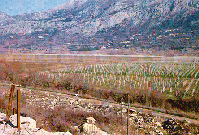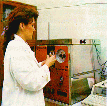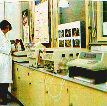Autochthonous populations of grapevines in Dalmatia are very old, and as a result of that genetic
changes occur. A splitting phenomenon is expressed inside individual populations and a phenomenon of
natural mutations. Concerning the mentioned changes, the populations of determined sorts are
permanently watched and certain types are separated - the clones that exhibited determined phenotypical
and genetic changes. The practical results of the selection, particularly the clone kind, are the enlarging of
the nature of the grape with better quality and the eradication of degenerate changes in the grapevine.
Some of the mentioned clones are turned over to the practice for elevating contemporary viticulture
objects (Vrgorsko polje, Petrovo polje, etc).
Besides hybridization and clone selection, the significance of scientific research in the problematics of
enriching the assortment of grape vine was actually the introduction of the best sorts in the world
assortment. The activity concerning the research of the introduced sorts was carried out in many phases.
After many years of research on the introduction of the grapevine sorts a few sorts are turned over to
practice:
Separated is a few table sorts with an early and late
maturation periods suitable for freezing and transport:
Primiera, Kalily, Alphanse Lovalee, Olivette and others.
Significant works of the department are related to the research of vine foundations. The research
immediately began after the showing of filoksera. The basic goal of the initial research was to introduce a
greater number of American grapevine sorts and hybrids (American and European vines) and to find a
foundation resistant to filoksera. Later research was directed
toward finding grapevines that are resistant to a line of important factors in growing of the grape vine: the
resistance to the content of lime in the dirt, drought, salt content, nematodes, good scaring and an adequate
influence on a line of traits of the injected European grapevine. With regards to the
observation of a different reaction by the European domestic vine grafted on vine foundations, different
ecological growth conditions and precision research was conducted in many localities of the Adriatic
region to ensure the most correct selection of the vine foundation for predetermined sorts of grape vines.
On the basis of that research the results answered the question concerning the
selection of vine foundations for the basic assortments in Dalmatia, and ground types as well. It was also
considered that this problem for now was completely solved. According to longterm research the
following researched vine foundations can be recommended:
There was significant work on the research of the development of the root net of vine foundations, root
net of specific sorts grafted on predetermined vine foundations, and on the absorption ability of individual
nutritional elements in
the ground. These works have a great scientific and practical meaning because on the basis of the
knowledge concerning the diffusion of the root net in the ground and the ability of absorption of specific
nutrients, applied are optimum
agrotechnical measures.
The department for viticulture and wine selling works on confirming grapevine optimal nutritional needs.
The research took on these problems: how and on what basis place the grapevines needs for nutritional
elements in relation to the quantity the grape vine takes from the ground each year (through the leaf, the
cut wood and grape).
The research of optimal fertilization are connected to the research of optimal agrotechnical measures in
their viticultural practice. When speaking of optimal application of agrotechnical measures, kept in mind
is the application of all innovations acquired by personal research or application of the results from other
areas of our country and other countries. In the first order of business this relates to the application of the
mechanization to the work in viticulture. Without that the maintenance of existing vineyards can not be
conceived, nor the realization of new programs in the following periods:
The application of growth shapes and armature, spacing of the plantings and herbicide, ampelographic and
agrotechnical measures that will in predetermined ambient-agrotechnical conditions most positively
influence the fertility and the quality of grapes.
In the research the agrotechnical measures are studied complexly and they are observed as a determined
system that is applied to the growing of grapevine on social and individual properties.
With the goal of developing and intensifying the planting production, the Department organized itself in
the specific localities of Dalmatia (Vis, Hvar, Korcula, Peljesac, Drnis, Imotski, Vrgorac), and with the
goal of production of
repromaterials (plemki of autochthonous and domestic sorts of grape vines) raised a central plantation with
the most suitable vine foundations. Centrally placed plantings of autochthonous and domesticated sorts of
grape vines: plavac, vugava, plavina,kuc, kujundzusa, marastina, posip, and some introduced types, as
plantings of foundations are under constant control of this
Institute, which performs sort and health control.
Besides the repromaterial (foundation and plemki) significant influence on the quality of planting
material have all processes involved in the production of vine grafts (grafting, stratification, prporenje).
With the goal of a contemporary and
qualitative production the Department, in cooperation with an organization "Poduh" from Metkovic,
organized a production of 2 000 000 grafts for the social and individual purposes in Dalmatia.
In the last few years significant work was done in regionalization of viticultural production and the
protection of the geographical descent of wine, which added a qualitative contribution to the further
advancement of the viticultural-wine selling production.
In a large field of work in regards to the regionalization of the viticultural-wine selling production in
Dalmatia, defined are viticultural geographical entities (regions,subregions, wine highlands, and localities)
and they are topographically and geographically marked. For the showing of the ecological factors of
viticultural units elaborated on are climactic and
pedologic e lements necessary for the graphing of the agroecological conditions of profitable growing of
grapevine. In the selection of sorts applied was the contemporary classification. All sorts were classified
in groups (not
permitted, permissible, recommended) that guarantee production of specific wine categories. In the
assortment was made a qualitative and a quantitative change that ensures not only a better sorting system,
but enables production of wine that would be most suitable in particular areas, due to ecological conditions,
to give best results.
In regionalization was offered a graph of surfaces under grapevines on social and personal properties.
The information collected through surveys was used. This enabled, for the first time in Dalmatia in many
years, the observation of surfaces under vineyards, the ageing structure, the sorting system, agrotechnical
conditions, production of grapes, reproduction and finishing capacities, their locations, etc.
The worked out elements of regionalization represent an excellent way to enhance the Dalmatian standard
in the field of viticulture and wine selling. Besides that, this is a base on which the interested parties may
agree to create programs for the advancement of production, finishing and traffic of the grape
and wine.
With regionalization the protection of geographical wine is accomplished. Before regionalization of
Dalmatian viticulture research was done on protecting wines geographical descent. On the basis of the
departments work, in 1961 was completed the protection of the wine "Dingac" (according to the
international plan of the Geneva convention). Soon thereafter was protected
the wine "Post up", then the famed white wines from Korcula,
"Posip" and "Marastina" , then "Faros" from the island of Hvar and the Primosten "Babic". The work on
geographical protection is continued. To this day, from the region of Dalmatia, over 60 sorts of wine are
protected with the stamp of their geographical descent, actually wines that are named for their
geographical highlands, and whose quality and character come from only the
natural factors of their surrounding.
The Department is connected to many viticulture-wine selling organizations in the Adriatic area. With
cooperation of the experts of those working organizations many actual problems are solved for the
viticulture-wineselling production.
Special activity of the Department is manifested in the project planning and advancing of contemporary
viticulture objects (Konavli, Vrgorac, Imotski, Drnis, Vis, etc).
The activity that envelops production and the quality of wine dates in the Institute from its establishment.
It is trusted that "Kimika" (a one time popular name for the Institute) was formed mostly because of the
need to raise the standard of the quality and the health of the wine a notch up. That was the time
when filoksera roamed across western Europe( the time of great conjuncture for Dalmatian wine).
If we observed viticultural activity from the founding date to today we could confirm the expertise of the
staff and the well equipped laboratories to have always been enough qualitative for making analytical and
professional work. The research work was at different times treated differently, a fact that can be
contributed to specific politics in viticulture, and less to the real necessities.
From the founding of the Institute to the beginning of the first world war , wine export had a tendency of
constant increase , which was conditioned by the wine crisis in Europe (filoksera) and the improvement in
the quality of Dalmatian wines. A multitude of analysis on the needs of internal and external
traffic demanded properly equipped laboratories and a continual perfecting of analytical work.
After the first world war started the first wine crisis that lasted a long time. The closing of the borders
towards Vienna, Prague, and other larger cities of Europe, hyperproduction of red wine for mixing and
low prices cause great havoc for the Dalmatian producers. You can not live on wine so much of the youth
emigrated. That was a crisis for the Institute which the kingship Serbia-Croatia-Slovenia forced to
perform routine lab work of a "chemical station".
It was only in 1925 that viticulture activity reactivated, and soon after the reorganization into a
Agricultural-testing and control station. Quickly thereafter in 1930 the law on wine came and demanded
impeccable work in analysis. That was a time of intense research and observation that was directed to:
After the second world war, more accurately when the Institute was formed into a federal
scientific-research institution, the entire activity, including viticulture, accepted new shapes of work.
Qualitative analysis and useful research to be applied to practice was a task for the wine experts. The
research of wines from particular regions and localities become actual, especially for those that have
successfully domesticated famed (domestic) sorts: plavac mali, the Greek, vugava, posip, etc. Also were
performed tests tied to confirming optimal technology of wine production.
Industrialization of wine selling in Dalmatia started after the 1950s. Created were new working
conditions in the field and a challenge for new observation and questions, therefore conditions for new
knowledge which (like the equipment ) could not be bought in foreign countries. The institute involved
itself in work of almost all wineries, and most often to confirm the type of production in new working
conditions.
The new conditions of production, increased fertility of grapes as a result of artificial fertilizer, bigger
demands from the consumer, all were reasons for the multitude of tests that were primarily responsible for
defining optimal sources of quality wines form the best positions in Dalmatia.
The most significant works of that period were:
testing
plavac from the Peljesac region (Dingac, Postup), Brač (Bol- Murvica), Hvar (Sv.Nedjelja, Ivan
Dolac) and Vis .
Then the testing of Babic wine from the Primosten region, the white wines Smokvica-Cara (posip,
marastina), Vis (vugava), in order to confirm the quality and create documentation for the geographical
protection.
With the acquisition of contemporary spectrophotometry, gas chromatography and high pressure liquid
chromatography, atomic absorber and other equipment used in classical analysis, the working conditions
became quite good.
Scientific research in the last decade at the Institute for viticulture and wine selling:
Beside scientific work the departmental activity was evident in the following:
The activity of the Institute in the last years were directed towards the following research:



1. Jobs performed according to contracts with trade organizations:
2. Functions enveloping the control of wine quality
3. Service functions of educational significance
